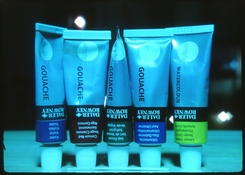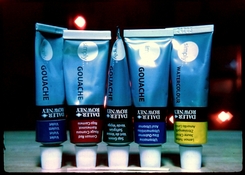the print stock in a previous generation or three DID have rem jet, But they current stock dropped that to avoid a wash step. when this was used as a theatre film, it was used by the mile, and mostly by TWO labs - Deluxe in Hollywood and Technicolor in Mirabel Quebec. Technicolor moved to Mirabell mostly because of the water restrictions in LA. the entire industry changed the way sound tracks were presented just to skip a wash step when processing the Print stock.
The print Stock, even if it is called "positive" was NEVER reversal processed. May year ago (we be talking decades) there were some reversal print stocks used to make 16mm prints as the early camera negative films were grainer than long gone 16mm Camera reversal films like "Ektachrome Commercial"
the film was intended to be exposed to tungsten light from a DDB projection lamp running at 90 Volts in a Bell and Howell type C Printer. the image source being an Eastman COlor Negative. I can't imagine an application more distant than taking images in a still camera.
there are Several Vison 3 colour negative films. All of which are intended to be used in a camera. and PRINTED on 2383/3383 The line includes a few "Lab Films" used to make Masked positives or masked negative in the Movie film process. the lab films tend to come in 2000 ft rolls.
PLEASE read the Kodak site
https://Kodak.com/go/motion under the categories of
camera film", "Lab Film" and Print film. found under the "Products" tab.
I don't know how many times it needs to be said, But the movie folks shoot a Camera film. they then if doing things conventionally make a MASKED master Positive from the Camera Negative on an intermediate film. That in turn is used to make several Masked printing negatives on another Intermediate film. Finaly a series of projection Prints are made on 2383/3383 to send out to be shown. The digital world often truncates this to shooting the Camera negative and scanning it, with all the other steps done as digital video.
Some folks play with sound film. A black and white stock used to record sound tracks. this lately has what is normaly the "edge" printing down the center of the film. The change was to leave the edges clear for the ill fated SONY SDDS system. I only metion this as if you want to get useful results out of Movie Stock you DO need to understand why they are so different from still stock.
















